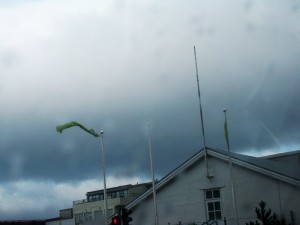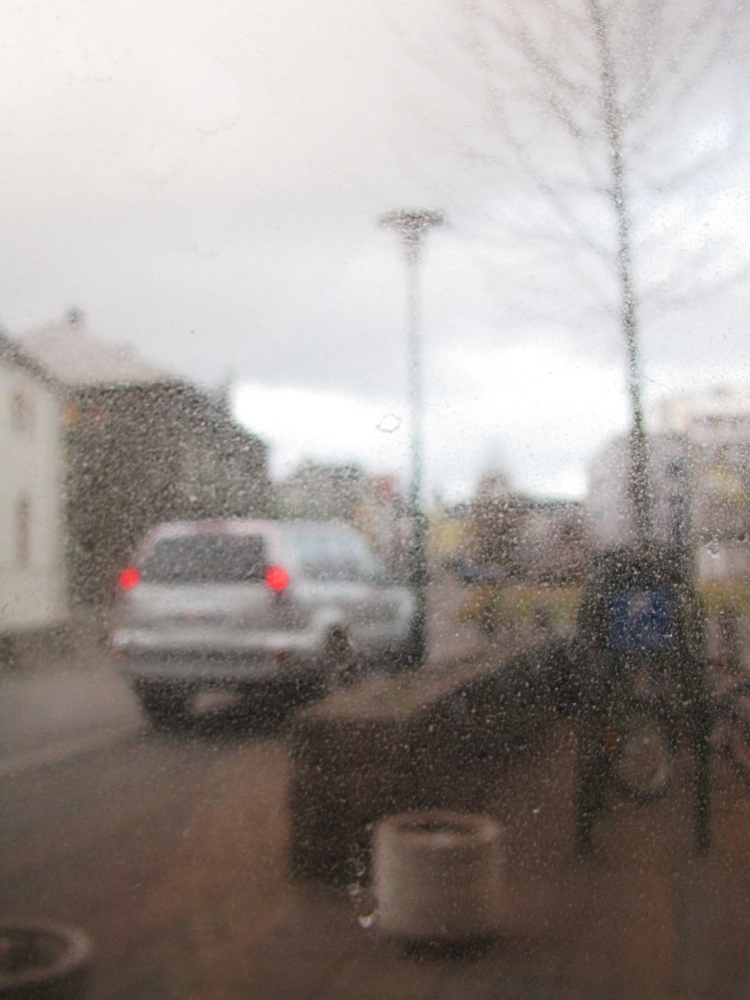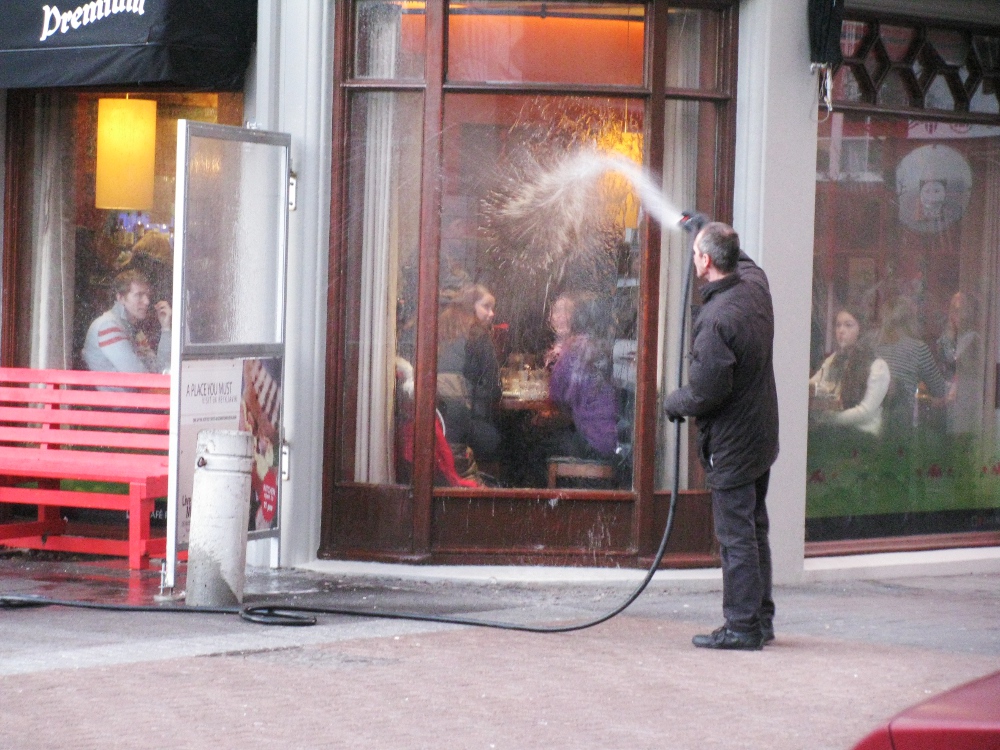Survive a storm in Iceland. Posted by hulda on Nov 4, 2012 in Icelandic customs
 Hello dear readers, I hope that everyone around the areas that Sandy hit are safe!
Hello dear readers, I hope that everyone around the areas that Sandy hit are safe!
Over here we had some stormy weather over the weekend as well, although it really couldn’t compare to Sandy. Storms are typical autumn weather for Iceland and with winds over 25m/s they can, however, still cause a lot of damage. Now the timing was also rather unlucky since the Iceland Airwaves music festival was this weekend. At places the weather got too harsh for people to walk outdoors so the festival arranged for special busses to take the festival goers from one venue to another.
Björgunarsveitinn, the Icelandic voluntary rescue units, have had their hands full again. A friend of mine was on duty from nine a.m. to the early evening on Friday, had a short nap and then returned to work. Their main concerns were boats and tying down half torn roofs, the first ones for obvious reasons and the second ones because large pieces of corrugated iron flying around in a storm are bad news for everyone. As far as I know the storm did not cause any casualties but the amount of ambulances sent was the highest of the whole year, over 100 emergencies during 24h.
Technically speaking, to weather a storm in Iceland all you need is shelter, time, a warm sweater and a cool head. A good book gets you a long way as well. Still, it’s a big plus if you actually know what you should be doing and especially what you should not be doing, since some very basic mistakes can turn a merely annoying situation into a potentially lethal one. It seems that every year a couple of tourists die or get injured in accidents that could easily have been prevented with a little bit of knowledge on the country itself. So how do you survive a storm in Iceland?
This is what every single window looks like at the moment. We’re all hoping it would rain a lot soon!
Number one advice is naturally to avoid it. Don’t go out of your house until it’s over unless you absolutely must. Stay in the cities. Do not drive out to the countryside! The wind that is strong enough to tear asphalt off the roads is also strong enough to give your car a good sideways push and throw rocks or, well, torn-off pieces of asphalt at it. This on its own may not yet be actually dangerous but it will dent and scratch your car and perhaps amount to other accidents as well.
The real danger is ice. The storms brought us a heavy amount of snow up north again which caused the mountain roads to ice over, and since it’s only the beginning of November not everyone’s changed to winter tires yet. No matter how badly you want to travel, always check the weather forecast first and if you see the words “Búist er við stormi” (= a storm is expected), delay it.
In case you’re already stuck in a ditch somewhere in the middle of Iceland as you read this, call the emergency number 112. Let them know which road you’re on and if you’re not absolutely clear of where you are, tell them which towns or villages you’ve recently passed. Landmarks such as large waterfalls, mountains (even better if you recognize one by name), glaciers or unusual stone formations can help you too. Roads in Iceland are few so unless you’ve gone off-road cruising they ought to be able to figure out an estimation of your location fairly easily.
Do not leave your car. Iceland does not get tornadoes, and even if the storms are of the severe kind very little grows here that could either fall on your car or be thrown against it. Except for rocks of course, but your car can still take flying rocks better than you.
Cafe Paris decided to not wait for a possible rain.
If there is no reception to make a call and you decide to risk going out in an attempt to see if you can find some, tie something to the car so you can find it again if either a blizzard or a mist rises while you’re outside. Both can happen in a manner of minutes and last for hours. During the Eyjafjallajökull eruption we had a case where a small group of Icelanders died after wandering off into a blizzard because of this and then being unable to return to their car. A typical reason for dying on the hálendur, highlands, is getting lost and freezing to death but both are likelier to happen on the outside of a car than on the inside of it.
So even at the worst of times, stay calm. Turn the emergency blinkers on. Eat something if you can. Drink some water. Sit still and figure out the situation and how much help you’re going to need. Will the weather permit you to walk back to the road and flag down a passing car or is anyone else even driving on the same road at all? What’s the temperature, visibility and wind like outside? The car will stay suitably warm for a good while and even if it begins to cool down it’s still a better option for waiting than going outside. The rescue units will spot a car easier than a person.
Most importantly, always check the weather before you head out. Veðurstofa Íslands offers a good amount of info on the weather and Vegagerðin shows you the current conditions of the roads all over Iceland. Always tell someone where you’re going and when you’re expected to return – if you don’t and your phone is out of reception they will send help after you. Whatever you do, don’t panic*.
Here are some links to Icelandic web pages concerning the storm. There’s some quite interesting photos included that can give you a better idea of what the weather can be like over here.
Björgunarsveitir enn að störfum (= rescue units still at work).
Nóg um að vera hjá Landsbjörg í dag. (= plenty going on at Landsbjörg today).
Tugir gáma fuku í gær (= dozens of shipping containers flew away yesterday).
Mesti snjór í manna minnum (= the most snow since anyone can remember)
Stormur í dag (= a storm today).
And do not miss this awesome video of how high the waves were by the sea side in Reykjavík!
*Remember to bring your towel.

Build vocabulary, practice pronunciation, and more with Transparent Language Online. Available anytime, anywhere, on any device.
About the Author: hulda
Hi, I'm Hulda, originally Finnish but now living in the suburbs of Reykjavík. I'm here to help you in any way I can if you're considering learning Icelandic. Nice to meet you!





